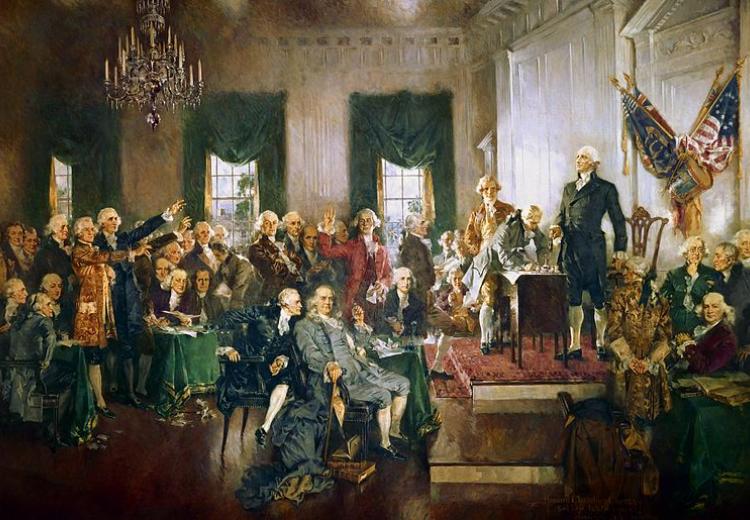Photography as Historical Record
From 1976-1981, the National Endowment for the Arts (NEA) sponsored a program of photographic surveys in 55 communities in 30 states across the United States to celebrate the bicentennial of the country’s founding. These surveys created a new visual record of a changing nation. NEH partnered with the Smithsonian American Art Museum to create educational resources that invite students to examine visual representations of individual communities as they consider larger trends in the changing American landscape.
We offer these resources both as a lesson plan, Visual Records of a Changing Nation, and as a student activity page, Analyzing Photographs from Across a Changing Nation.
Arts & Civil Rights
These EDSITEment resources explore works of art by Black artists connected to the fight for civil rights in the United States.
- Media Resource: Jazz Ambassadors: The United States tried to leverage African American jazz musicians to bolster its international image during the Cold War, but the artists were unafraid to speak honestly about the inequalities faced by African Americans in their country.
Compelling Questions & Connections
- How have different artists represented parts of the experiences of Black Americans?
- What cultural, social, and institutional contexts contributed to the production of these works of art and music?
- Explore other dimensions of African American and Black American arts with these EDSITEment resources:
Architecture & the American Dream
The places we live and work are bound up with our sense of self, and with reason. They shape how others see us, the communities of which we're a part, and the opportunities to which we have (or don't have) access. These lessons explore some of the ways architecture has shaped life in the United States.
Compelling Questions & Connections
- How does the growth of suburbs in the second half of the twentieth century connect to larger themes in U.S. history?
- The Media Resource Thurgood Marshall Before the Court includes activities and questions addressing the lasting effects of residential segregation, in which suburbanization plays a major role.
The American Landscape: Art & Nature
A recurring theme in American art is the relationship between humans and nature. These resources explore the ways artists have grappled with and represented that relationship, from the euphoric to the deeply pessimistic, and offer an opportunity for students to reflect on the current state of the human-environment relationship.
Compelling Questions & Connections
- What tensions do you notice in the human-nature relationship as portrayed in these works of art?
- What is the role of technology in this relationship? The Media Resource BackStory: Man vs. the Machine - Technophobia and American Society provides additional discussion on the place of technology and technophobia in U.S. history.
- How are the transformations wrought by humans on the landscape been represented by artists over time? What aspects of these transformations are not visible in these works of art? The Lesson Plan The Impact of the Transcontinental Railroad (grades 6-8) provides one example of a major infrastructure project and its effects.
- EDSITEment has a range of resources for exploring local landscapes and the forces that have shaped them: the Media Resource Exploring Local History with Clio and the Teacher's Guide Investigating Local History are good places to start.
Picturing America
Picturing America, an NEH project, brought artistic masterpieces to K-12 classrooms. EDSITEment has created a series of media resources for some of these artworks, which include comprehension and discussion questions, as well as ways to draw connections between art and other subjects. The following media resources connect to the "A More Perfect Union" initiative.
- Picturing America: Pottery and Baskets: Learn about the art of indigenous peoples of North America and how knowledge of technique and craftsmanship is passed from one generation to the next for hundreds and thousands of years.
- Picturing America: Saint-Gaudens & Homer: The Civil War was a devastating conflict. Hundreds of thousands of people died, and those veterans that survived the war faced the prospect of returning to "normal life." Augustus Saint-Gauden's "Shaw Memorial" and Winslow Homer's "The Veteran in a New Field" represent two artists' attempts to grapple with the aftermath of the war.
- Picturing America: "The Sources of Country Music" and "The County Election": Study Thomas Hart Benton's "The Sources of Country Music" and George Bingham's "The County Election," analyzing their representation of American democracy and public life.
-
Picturing America: Dorothea Lange's "Migrant Mother": Dorothea Lange's photograph of a migrant woman in Nipomo, California has become one of the most iconic and easily-recognizable images of the Great Depression. Learn more about the photograph, and Lange's other work, with this video from Picturing America.
- Picturing America: Washington & Selma: This video connects the founding of the United States to the fight for Civil Rights through the work of Emmanuel Leutze and James Karales.
Compelling Questions & Connections
- Which works of art do you recognize? Which are unfamiliar?
- How does each work of art connect to and/or complicate the theme of "a more perfect union"?
- What do you notice about the artists who created the works of art in the Picturing America series? Who is represented and how?
- Who is represented, and how, in these works of art?

